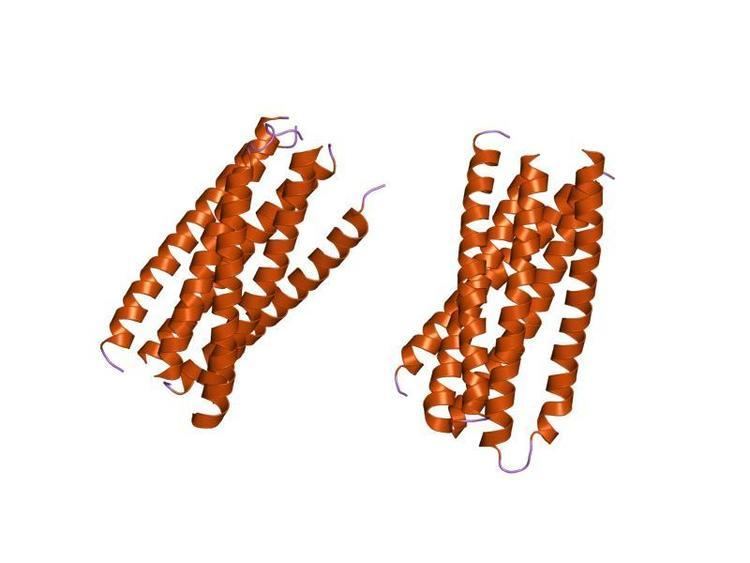Symbol GP41 InterPro IPR000328 SUPERFAMILY 2siv | Pfam PF00517 SCOP 2siv Pfam structures | |
 | ||
Gp41 also known as glycoprotein 41 is a subunit of the envelope protein complex of retroviruses, including human immunodeficiency virus (HIV). Gp41 is a transmembrane protein that contains several sites within its ectodomain that are required for infection of host cells.
Contents
Gene and post-translational modifications
The env gene codes for gp160, a precursor, which is extensively glycosylated and proteolytically cleaved into two subunits gp120 and gp41 (this protein) by furin, a host cellular protease.
Structure
HIV uses envelope spike complexes that allow it to fuse with and infect host cells. These spike complexes are made up of glycoproteins gp41 and gp120. Gp120 is a surface protein while gp41 is a transmembrane glycoprotein, both of which are non-covalently bound to each other.
Gp41 has three prominent regions within the sequence: the ectodomain, the transmembrane domain, and the cytoplasmic domain. The ectodomain, which comprises residues 511-684, can be further broken down into the fusion peptide region (residues 512-527), the helical N-terminal heptad repeat (NHR) and C-terminal heptad repeat (CHR). In addition to these regions, there is also a loop region that contains an important disulfide bond and a region called the membrane proximal external region (MPER) which contains antigen target regions.
Function
In a free virion, the fusion peptides at the amino termini of gp41 are buried within the envelope complex in an inactive non-fusogengic state that is stabilized by a non-covalent bond with gp120. Gp120 binds to a CD4 and a co-receptor (CCR5 or CXCR4), found on susceptible cells such as Helper T cells and macrophages. As a result, a cascade of conformational changes occurs in the gp120 and gp41 proteins. These conformational changes start with gp120 that rearranges to expose the binding sites for the coreceptors mentioned above. Once these coreceptors bind, the core of gp41 folds into a six helical bundle structure exposing the previously hidden gp41 fusion peptides which then assist in the fusion with the host cell, which is facilitated by the hairpin conformational structure. The inner core of this conformation is 3 NHR which have hydrophobic pockets that allow it to bind to specific residues on the CHR. The core of gp41 folds into a six helical bundle structure exposing the previously hidden gp41 fusion peptides which then assist in the fusion with the host cell. The activation process occurs readily which suggest that the inactive state of gp41 is metastable and the conformational changes allow gp41 to achieve its more stable active state.
As a drug target
The interaction of gp41 fusion peptides with the target cell causes a formation of an intermediate, pre-hairpin structure which bridges and fuses the viral and host membranes together. The pre-hairpin structure has a relatively long half-life which makes it a target for therapeutic intervention and inhibitory peptides.
Enfuvirtide (also known as T-20) is a fusion inhibitor drug that binds to the pre-hairpin structure and prevents membrane fusion and HIV-1 entry to the cell. The vulnerability of this structure has initiated development towards a whole spectrum of fusion preventing drugs. In developing these drugs, researchers face challenges because the conformation that allows for inhibition occurs very quickly and then rearranges. Enfuviritide specifically has a low oral availability and is quickly processed and expelled by the body. Certain strains of HIV have also developed resistance to T-20. In order to circumvent the difficulties that come with using T-20, researchers have sought out peptide-based inhibitors. A variety of naturally occurring molecules have also been shown to bind gp41 and prevent HIV-1 entry.
Other targets that could prove to be effective include the hydrophobic pockets of the NHR core that is formed following the conformational change in gp41 that creates the six-helix bundle. These pockets could potentially serve as targets for small molecule inhibitors. N36 trimers and C34 trimers can also act as effective antigens because of their high affinity binding. In addition to having a much higher affinity for binding when compared to its monomer, C34 also inhibits T-20 resistant HIV very well, which makes it a potentially good alternative to treatments involving enfuviritide.
